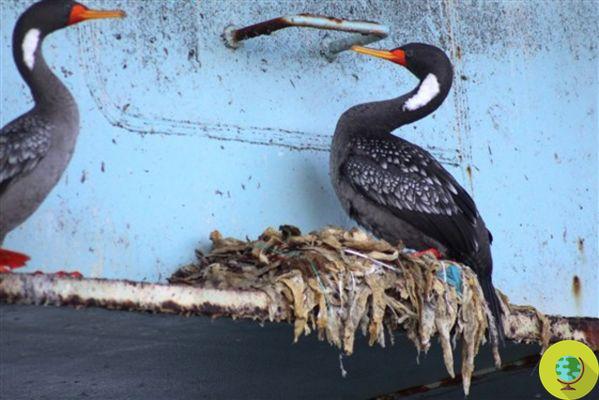The red-legged cormorant uses plastic to build its nest in Chile: it is a real environmental problem
Once the red-legged cormorants used algae, feathers and guano to build their nests, today their houses are made with plastic waste. A new article published in the Marine Pollution Bulletin magazine tells what is happening along the Atacama coast in northern Chile. In Mejillones Bay, a port city, plastic waste is abundant and is affecting the way animals live. Because there is not only the problem of marine pollution.
"This may be the most contaminated colony in the world," said Ana García-Cegarra, professor of biology at the University of Santo Tomás Antofagasta and author of the study on cormorants together with the non-profit Center for Marine Fauna and Whale Watching. " studies have found that 80% of the nests in a colony were made of plastic, we have seen that in 151 nests, 100% were plastic ”.
Photos taken by the researchers show how red-legged cormorants build their nests with plastic bags, nylon fishing tackle, and industrial tarpaulins. Pollution is dismantling oceanic and coastal ecosystems and perhaps only now, we are realizing it.

Center for the observation of marine fauna and whales
Plastic debris affects the survival of numerous species such as seabirds. Several studies report that plastic suffocates animals, but only a few describe the presence of this material in nests.
"Here we report evidence that the colony of red-legged cormorants (Phalacrocorax gaimardi) is using plastic as nesting material in two major port facilities in northern Chile," the study read.
Specifically, from the sampling of the nests, it emerged that they are composed of 35% industrial polypropylene bags, plastic bags (33%) and fishing gear (10%).
"It is only in the past five years or so that we have seen a surge in studies revealing the true extent of the amount of plastic contamination on our planet, with its damaging effects in our oceans," said Mauricio Urbino. a zoologist at the University of Concepcion in Chile. "The worrying thing is that if we don't reduce the use of plastic now, things will get worse."
García-Cegarra explains that plastic is dangerous for birds, which is why many cormorants were mortin 'nests. The two main threats are that the birds get entangled and starve or otherwise ingest plastic and suffocate.
“Since these birds are underwater, they probably collect plastic from the sea floor and transfer it to their nests,” said García-Cegarra.
The Antofagasta region, where the bay is located, is one of the richest in Chile due to the high amount of extractive industries. Mejillones, about 40 miles north of the regional capital was historically a small fishing town that began to grow in the 1800s.
“Our bad habits in consuming plastic are affecting all marine fauna, now reaching bird nests, the depths of the ocean and even ending up on our table through fish that ingest it,” said García-Cegarra. "We need to act now and reduce our plastic consumption."
Fonte: Research Gate
Read also:
- Bees are building nests with our plastic waste
- The birds are eating hundreds of bits of plastic every day, according to new studies
- Animals suffocated by plastic: the shock campaign on the effects of pollution


























